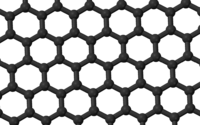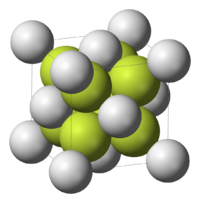- Coordination number
-
In chemistry and crystallography, the coordination number of a central atom in a molecule or crystal is the number of its nearest neighbours. This number is determined somewhat differently for molecules and for crystals.
In chemistry, the emphasis is on bonding structure in molecules or ions and the coordination number of an atom is determined by simply counting the other atoms to which it is bonded (by either single or multiple bonds). For example, [Cr(NH3)2Cl2Br2]1- has Cr3+ as its central cation, which has a coordination number of 6.
However the solid-state structures of crystals often have less clearly defined bonds, so a simpler model is used, in which the atoms are represented by touching spheres. In this model the coordination number of an atom is the number of other atoms that it touches. For an atom in the interior of a crystal lattice, the number of atoms touching the given atom is the bulk coordination number; for an atom at a surface of a crystal, this is the surface coordination number.
Contents
Chemistry usage
In chemistry, coordination number (c.n.), defined originally in 1893 by Alfred Werner, is the total number of neighbours of a central atom in a molecule or ion.[1][2] Although a carbon atom has four chemical bonds in most stable molecules, the coordination number of each carbon is four in methane (CH4), three in ethylene (H2C=CH2, each C is bonded to 2H + 1C = 3 atoms), and two in acetylene. In effect we count the first bond (or sigma bond) to each neighbouring atom, but not the other bonds (pi bonds).
In inorganic chemistry also, only the first or sigma bond between each ligand and the central atom counts, but not any pi bonds to the same ligands. In tungsten hexacarbonyl, W(CO)6, the coordination number of tungsten (W) is counted as six although pi as well as sigma bonding is important in such metal carbonyls.
Examples of high coordination number complexes are the ions formed by uranium and thorium with bidentate nitrate ion ligands, U(NO3)62− and Th(NO3)62−. Here each nitrate ligand is bound to the metal by two oxygen atoms, so that the total coordination number of the U or Th atom is 12.
When the surrounding ligands get smaller even higher coordination numbers may be possible. One computational chemistry study predicted a particularly stable PbHe152+ ion composed of a central lead ion coordinated with no fewer than 15 helium atoms.[3]
Crystallography usage
In materials science, the bulk coordination number of a given atom in the interior of a crystal lattice is the number of atoms touching the given atom. Iron at 20oC has a body-centered cubic (BCC) crystal in which each interior iron atom occupies the centre of a cube formed by eight neighbouring iron atoms. The bulk coordination number for this structure is therefore 8.
The highest bulk coordination number is 12, found in both hexagonal close-packed (HCP) and cubic close-packed (CCP) (also known as face-centered cubic or FCC) structures. This value of 12 corresponds to the theoretical limit of the kissing number problem when all spheres are identical.
The two most common allotropes of carbon have different coordination numbers. In diamond, each carbon atom is at the centre of a tetrahedron formed by four other carbon atoms, so the coordination number is four, as for methane. Graphite is made of two-dimensional layers in which each carbon is covalently bonded to three other carbons. Atoms in other layers are much further away and are not nearest neighbours, so the coordination number of a carbon atom in graphite is 3 as in ethylene.
Simple ionic structures are described by two coordination numbers, one for each type of ion. Calcium fluoride (CaF2) is an (8, 4) structure, meaning that each cation Ca2+ is surrounded by eight F− anion neighbors, and each anion F− by four Ca2+. For sodium chloride (NaCl), the numbers of cations and anions are equal, and both coordination numbers are six so that the structure is (6, 6).
For an atom at a surface of a crystal, the surface coordination number is always less than the bulk coordination number. The surface coordination number is dependent on the Miller indices of the surface. In a body-centered cubic (BCC) crystal, the bulk coordination number is 8, whereas, for the (100) surface, the surface coordination number is 4.
Usage in quasicrystal, liquid and other disordered systems
The coordination number of systems with disorderness cannot be precisely defined.
The first coordination number can be defined using the radial distribution function g(r) [4] [5]

where r0 is the rightmost position starting from r = 0 whereon g(r) is approximately zero, r1 is the first minimum. Therefore, it is the area under the first peak of g(r).
The second coordinate number is defined similarly:
Alternative definitions for the coordination number can be found in literature, but in essence the main idea is the same. One of those definition are as follows: Denote rp as the position of the first peak,

The first coordination shell is the spherical shell with radius between r0 to r1 around the central particle under investigation.References
- ^ De, A.K: "A Text Book of Inorganic Chemistry", page 88. New Age International Publishers, 2003.
- ^ IUPAC, Compendium of Chemical Terminology, 2nd ed. (the "Gold Book") (1997). Online corrected version: (2006–) "coordination number".
- ^ The Search for the Species with the Highest Coordination Number Andreas Hermann, Matthias Lein, and Peter Schwerdtfeger Angew. Chem. Int. Ed. 2007, 46, 2444 –2447 doi:10.1002/anie.200604148
- ^ Yoshio Waseda, The Structure of Non-crystalline Materials - Liquids and Amorphous Solids, McGraw-Hill, New York, 1980, pp. 48-51.
- ^ X-ray diffraction study of liquid sulfur, K S Vahvaselkä and J M Mangs Phys. Scr. 1988 38 737 doi:10.1088/0031-8949/38/5/017
External links
Categories:- Chemical bonding
- Materials science
- Coordination chemistry
Wikimedia Foundation. 2010.





